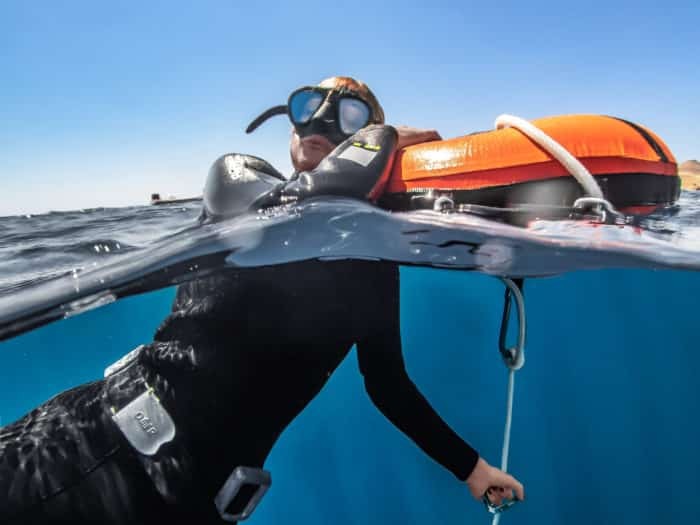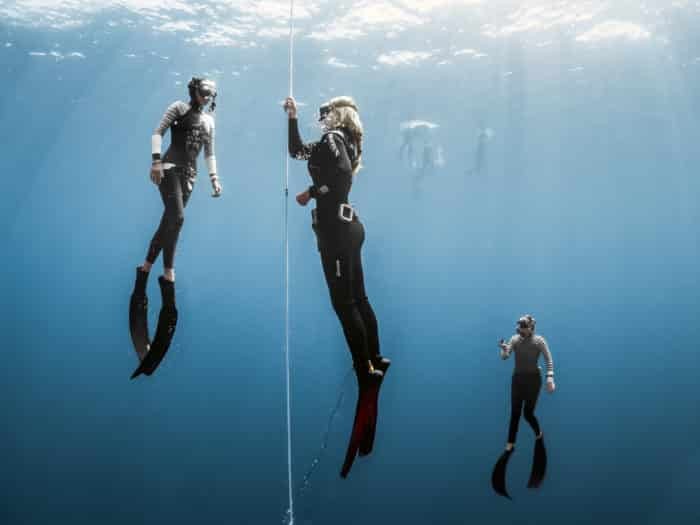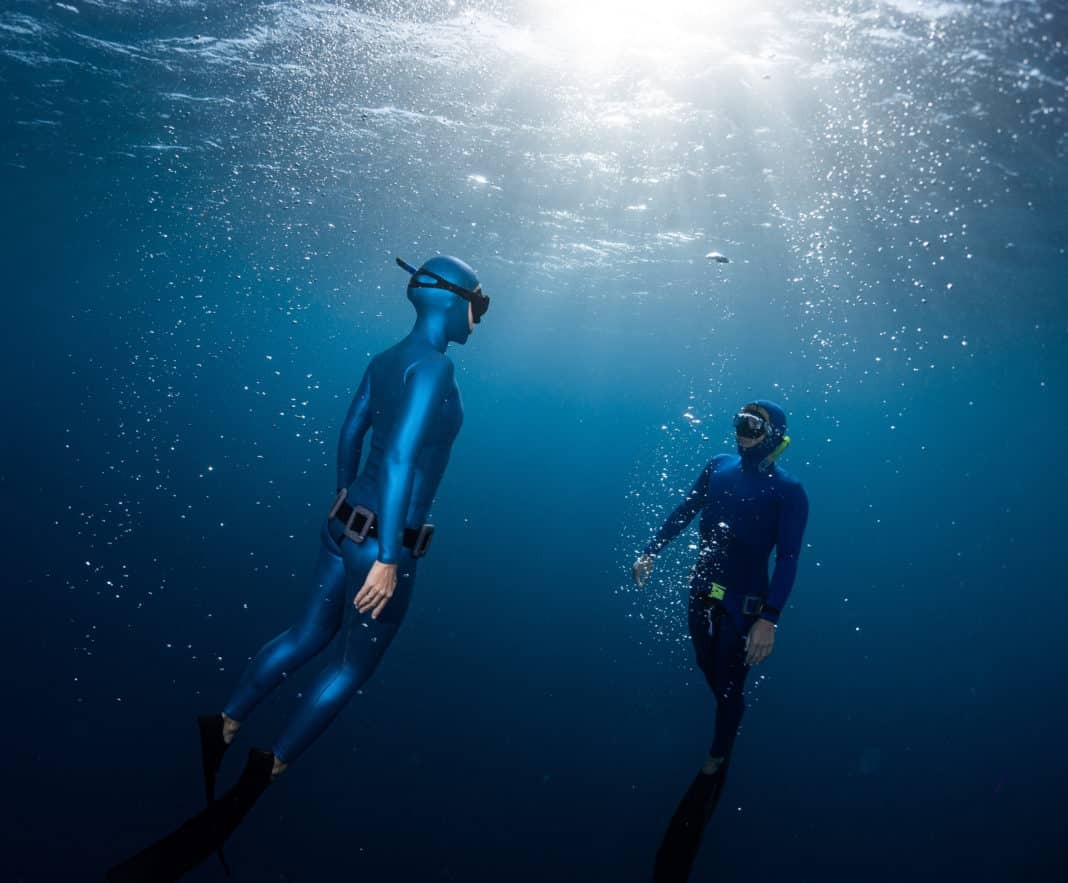Decompression sickness was originally thought to only occur in scuba diving and working in high-pressure environments. However, research shows that breath-hold diving (freediving) also poses its own risks for developing decompression sickness (DCS), also referred to as being bent or getting the bends. We will take a look at what exactly DCS is, how it relates to freediving, how we can prevent this in our own dives, and what you should do if you feel that you or a fellow diver is experiencing signs and symptoms of DCS.
What is DCS?
DCS is caused by nitrogen bubbles forming in the tissues of the body when sudden decompression occurs. When you breathe in air (which consists of 21% oxygen and 78% nitrogen), your body uses the oxygen but does nothing with the nitrogen, and some of both gases are dissolved in the fluid portions of your blood and tissues. This is not a problem when you are on land (in normal atmospheric pressure).
But when you descend underwater, the pressure increases, which means more nitrogen and oxygen dissolve in your blood. Oxygen is consumed by your tissues, but nitrogen remains. With a slow ascent, your body is relieved of pressure and the nitrogen is slowly released. If the ascent is rapid, nitrogen comes out of blood and tissues quickly, forming bubbles. These bubbles can block tiny blood vessels, which can lead to joint pain, ruptured blood vessels in the lungs, stroke, or heart attack.
How does DCS relate to freediving?

Since scuba divers inhale pressurized air, they need to be especially aware of ascending slowly (allowing nitrogen to come out of their exhalations), spending only a certain amount of time at each depth (preventing the accumulation of too much nitrogen), and long surface intervals (to allow the excess nitrogen out of their body before accumulating more on the next dive).
Freedivers do not inhale pressurized air, but the final breath we take before a dive still contains nitrogen from the atmosphere, which will still pressurize at depth. Nitrogen accumulation still happens, just very little compared to scuba divers. So then why do people performing breath-hold dives, such as spearfishers, deep freediving athletes, and pearl divers in the Pacific area, still get DCS?
Short surface interval times
If you are diving to depths of 20m (65ft) and 30m (98ft), DCS is not likely to happen in one dive. This is due to nitrogen build-up being relatively low from a single dive. But pearl divers in the Pacific area and spearfishers may dive for hours on end, with numerous dives to these depths, and not take long enough surface interval times between dives. This means that nitrogen is slowly building up in the blood and not being fully released at the surface before the next dive. With enough repetitive dives like this, the possibility of too much nitrogen build-up in the body arises, resulting in the diver presenting signs and symptoms of DCS. This also applies to safety dives you perform.
Multiple deep dives
The deeper you go, the more nitrogen you will accumulate in your blood and tissues. Ascending too quickly from deep depths can also cause these bubbles to appear since the pressure is swiftly decreasingly. There is not many studies in this area of freediving and DCS, so there is no concrete way to tell what is too deep and how many dives you can actually perform at these depths; it is best to err on the side of caution, which is covered below.
Mixing freediving and scuba diving
Since you are breathing compressed air while scuba diving, more nitrogen is accumulated in your tissues. This is why you should not fly directly after scuba diving, in order to release excess nitrogen in your body. The same applies to freediving after scuba diving; since you will still be accumulating nitrogen in your body, it is not a good idea to freedive directly after or in between scuba dives and vice versa.
Physiological factors
If two freedivers perform the exact same dives, to the same depth, with the same surface interval times, to the point of feeling symptoms of DCS, this does not mean that both of them will necessarily get DCS. This is due to the fact that there are many factors that may influence one’s susceptibility to get DCS, such as age, body composition, hydration, level of fatigue, temperature, and medications.
How can we prevent DCS?

Calculating surface interval times
This can be calculated by using the following formulas. Remember that this includes surface interval time for safety diving as well.
Dives up to 30m (98ft): Dive time x 2
Example: 20m (65ft) dive that takes 1 minute
1:00 x 2 = 2-minute surface interval
Dives up to 60m (196ft): Depth (in meters) / 5
Example: 50m (164ft) dive
50 / 5 = 10-minute surface interval
Limiting session duration
Keep dive sessions 2 hours or shorter, no matter the temperature of the water. If you are cold, end the session.
Limiting deep dives
Any dives deeper than 55m (180ft) should be limited to only dive per day. It is recommended to breathe 100% oxygen for at least 10 minutes at the surface after the dive to clear excess nitrogen from your system (do not dive again for the rest of the day after breathing 100% oxygen).
Ascending at a normal speed
Do not exceed a speed of 1m/s (3ft/s) on your ascent.
Not mixing freediving, scuba diving, and flying
Follow the no-fly times on your dive computer, or use the rule of thumb: no scuba diving after freediving for 12 hours, no freediving after scuba diving for 24 hours. Observe the same hours for getting on an airplane.
Diving healthy
Before and during a training session, be well-rested and stress-free, avoid strenuous exercise, avoid diving while feeling ill, and avoid alcohol the day before diving.
Staying hydrated
Hydrating well before, during, and after a training session is important, as freediving is seriously dehydrating. Try to drink 1L of water before the session, drink throughout the session, and have 1L of water after the session.
Signs and Symptoms of DCS
- Joint and muscle pain
- Sensitive, painful, or itchy skin
- Rashes
- Tingling, numbness, or paralysis
- Confusion
- Coughing (or coughing up blood)
- Chest pain
- Dizziness or vertigo
- Vomiting
- Headache
- Memory loss
- Loss of hearing or ringing in the ears
- Visual disturbances
- Unequal pupil size
- Slurred speech
- Nausea
- Shortness of breath
- Weakness
- Swelling
- Uncontrollable shaking
- Loss of consciousness
If you or your buddy feel like you are exhibiting any signs or symptoms of DCS within 48 hours after your return to the surface, exit the water, lie down (unless there is trouble breathing) and administer 100% pure oxygen, drink 1L of water per hour, and contact local emergency medical services.
Want to learn more or how to freedive? Our comprehensive beginner’s guide to freediving covers everything from the basics of freediving, like equalization and safety, to more advanced concepts like competition diving.


Comments are closed.